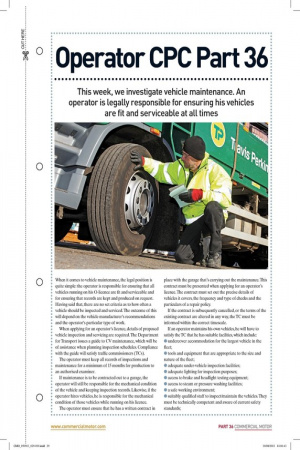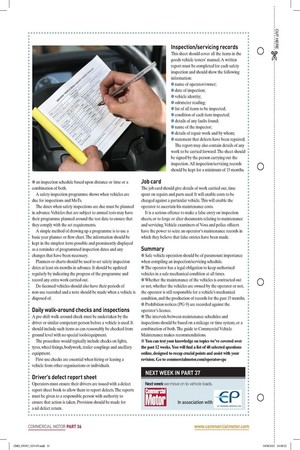Operator CPC Part 36 This week, we investigate vehicle maintenance.
Page 22

Page 23

If you've noticed an error in this article please click here to report it so we can fix it.
An operator is legally responsible for ensuring his vehicles are fit and serviceable at all times
When it comes to vehicle maintenance, the legal position is quite simple: the operator is responsible for ensuring that all vehicles running on his 0-licence are fit and serviceable and for ensuring that records are kept and produced on request. Having said that, there are no set criteria as to how often a vehicle should be inspected and serviced. The outcome of this will depend on the vehicle manufacturer's recommendations and the operator's particular type of work.
When applying for an operator's licence, details of proposed vehicle inspection and servicing are required. The Department for Transport issues a guide to CV maintenance, which will be of assistance when planning inspection schedules. Compliance with the guide will satisfy traffic commissioners (TCs).
The operator must keep all records of inspections and maintenance for a minimum of 15 months for production to an authorised examiner.
If maintenance is to be contracted out to a garage, the operator will still be responsible for the mechanical condition of the vehicle and keeping inspection records. Likewise, if the operator hires vehicles, he is responsible for the mechanical condition of those vehicles while running on his licence. The operator must ensure that he has a written contract in
place with the garage that's carrying out the maintenance. This contract must be presented when applying for an operator's licence. The contract must set out the precise details of vehicles it covers, the frequency and type of checks and the particulars of a repair policy.
If the contract is subsequently cancelled, or the terms of the existing contract are altered in any way, the TC must be informed within the correct timescale. If an operator maintains his own vehicles, he will have to satisfy the TC that he has suitable facilities, which include: • undercover accommodation for the largest vehicle in the fleet; • tools and equipment that are appropriate to the size and nature of the fleet; • adequate under-vehicle inspection facilities; • adequate lighting for inspection purposes; • access to brake and headlight testing equipment; • access to steam or pressure washing facilities; • a safe working environment; • suitably qualified staff to inspect/maintain the vehicles. They must be technically competent and aware of current safety standards; Inspection/servicing records This sheet should cover all the items in the goods vehicle testers' manual. A written report must be completed for each safety inspection and should show the following information: • name of operator/owner; • date of inspection; • vehicle identity; • odometer reading; • list of all items to be inspected; • condition of each item inspected; • details of any faults found; • name of the inspector; • details of repair work and by whom; • statement that defects have been repaired;
The report may also contain details of any work to be carried forward. The sheet should be signed by the person carrying out the inspection. All inspection/servicing records should be kept for a minimum of 15 months.
• an inspection schedule based upon distance or time or a combination of both.
A safety inspection programme shows when vehicles are due for inspections and MoTs.
The dates when safety inspections are due must be planned in advance. Vehicles that are subject to annual tests may have their programme planned around the test date to ensure that they comply with the set requirements.
A simple method of drawing up a programme is to use a basic year planner or flow chart. The information should be kept in the simplest form possible and prominently displayed as a reminder of programmed inspection dates and any changes that have been necessary.
Planners or charts should be used to set safety inspection dates at least six months in advance. It should be updated regularly by indicating the progress of the programme and record any extra work carried out.
De-licensed vehicles should also have their periods of non-use recorded and a note should be made when a vehicle is disposed of. Daily walk-around checks and inspections
A pre-shift walk-around check must be undertaken by the driver or similar competent person before a vehicle is used. It should include such items as can reasonably be checked from ground level with no special tools/equipment.
The procedure would typically include checks on lights, tyres, wheel fixings, bodywork, trailer couplings and ancillary equipment.
First-use checks are essential when hiring or leasing a vehicle from other organisations or individuals. Driver's defect report sheet
Operators must ensure their drivers are issued with a defect report sheet book to allow them to report defects. The reports must be given to a responsible person with authority to ensure that action is taken. Provision should be made for a nil defect return. Job card
The job card should give details of work carried out, time spent on repairs and parts used. It will enable costs to be charged against a particular vehicle. This will enable the operator to ascertain his maintenance costs.
It is a serious offence to make a false entry on inspection sheets, or to forge or alter documents relating to maintenance and servicing. Vehicle examiners of Vosa and police officers have the power to seize an operator's maintenance records in which they believe that false entries have been made. Summary
• Safe vehicle operation should be of paramount importance when compiling an inspection/servicing schedule.
• The operator has a legal obligation to keep authorised vehicles in a safe mechanical condition at all times.
• Whether the maintenance of the vehicles is contracted out or not, whether the vehicles are owned by the operator or not, the operator is still responsible for a vehicle's mechanical condition, and the production of records for the past 15 months.
• Prohibition notices (PG 9) are recorded against the operator's licence.
• The intervals between maintenance schedules and inspections should be based on a mileage or time system, or a combination of both. The guide to Commercial Vehicle Maintenance makes recommendations. • You can test your knowledge on topics we've covered over the past 12 weeks. You will find a list of 48 selected questions online, designed to recap crucial points and assist with your revision. Go to conunercialmotor.com/operator-cpc









































